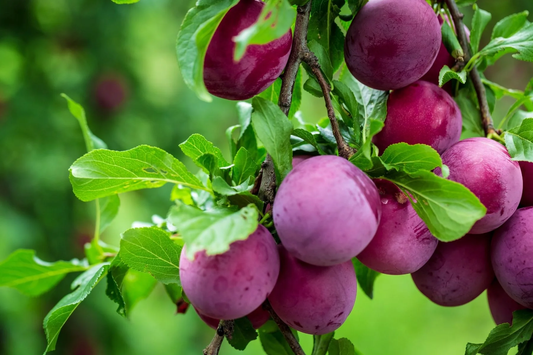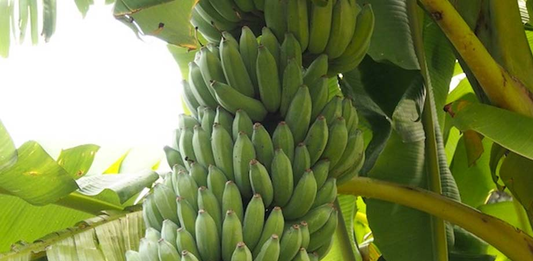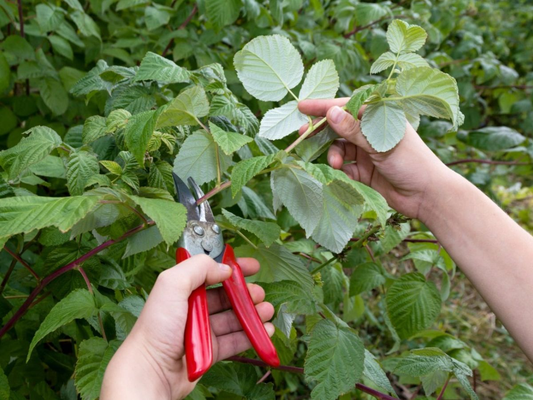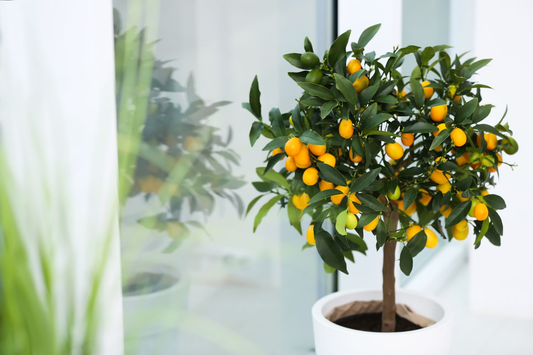Mango Magic: How to Plant Mango Seeds and Harvest Juicy Fruit at Home!
Share
Table of Contents
1. Introduction
Overview of Mangoes:
Mangoes, known as the "King of Fruits," are enjoyed worldwide for their sweet, juicy, and tropical flavor. They are a staple in many cuisines, especially in tropical and subtropical regions. Mangoes come in various types, including Ataulfo, Haden, Kent, and Tommy Atkins, each offering its unique taste and texture. Whether eaten fresh, blended into smoothies, or used in savory dishes, mangoes are a beloved fruit that everyone enjoys.
- Popularity: Mangoes are loved globally, particularly in summer, for their refreshing taste.
- Versatility: They can be eaten raw, made into jams, chutneys, and desserts, or even used in savory dishes.
- Nutritional Value: Mangoes are rich in vitamins, antioxidants, and fiber, offering numerous health benefits.
Why Plant Mango Seeds at Home?
Planting mango seeds at home allows you to grow your very own tropical paradise. There are several advantages to growing a mango tree, whether you have a large backyard or a small balcony.
- Fresh Mangoes: Enjoy homegrown mangoes that are fresher and more flavorful than store-bought options.
- Aesthetic Value: A mango tree can add a tropical, lush feel to your garden or living space.
- Sustainability: Growing your own mango tree is an eco-friendly way to produce fruit without relying on mass production, reducing your carbon footprint.
- Sense of Accomplishment: Watching your mango tree grow and produce fruit provides a sense of achievement and satisfaction.
What Readers Can Expect:
This guide will provide a step-by-step process on how to plant mango seeds and care for mango trees at home. You'll learn everything from extracting the seeds to nurturing your tree as it grows and eventually bears fruit.
- Step-by-Step Guide: Learn how to extract, prepare, and plant mango seeds.
- Caring for Your Mango Tree: Understand how to water, fertilize, and protect your tree for healthy growth.
- Harvesting Mangoes: Discover how to identify when your mangoes are ripe and ready for picking.
- Problem Solving: Tips for troubleshooting common issues with mango trees and seeds.

2. Understanding Mango Seeds: Types and Characteristics
Different Types of Mango Seeds:
Mangoes come in a variety of types, each with its unique characteristics. Understanding these varieties is essential when choosing which seeds to plant at home. Some popular mango varieties include:
- Ataulfo: Known for its creamy texture and small, yellow fruit. Ataulfo mangoes are sweet and less fibrous, making them ideal for fresh consumption.
- Haden: This variety is medium to large in size with a rich flavor and vibrant red skin. It's commonly found in grocery stores and is great for both eating fresh and making mango products.
- Kent: Kent mangoes are known for their smooth, tender flesh with fewer fibers. They are large, greenish-yellow when ripe, and are perfect for smoothies and desserts.
- Tommy Atkins: One of the most widely recognized mango varieties, known for its firm texture and bright red skin. It’s commonly used in salads, smoothies, and salsas.
Seed Structure and Components:
Understanding the structure of a mango seed is crucial for successful planting. The seed consists of several components:
- Outer Husk: The hard, woody shell that surrounds the seed. It must be removed before planting, though some people choose to leave it on for initial sprouting.
- Inner Seed: The edible part of the mango, which contains the embryo that will grow into a mango tree. The seed is typically white or off-white and should be kept moist for sprouting.
- Embryo: The actual plant inside the seed, which will begin to germinate and eventually grow into a mango tree when properly cared for.
Best Varieties for Home Planting:
Some mango varieties are better suited for home planting due to their growth habits and climate adaptability. Consider the following varieties for home cultivation:
- Ataulfo: Ideal for small spaces, this variety is compact and produces small fruit, making it perfect for container growing.
- Kent: Known for its good disease resistance and large fruit size, Kent mangoes grow well in tropical and subtropical climates.
- Tommy Atkins: Easy to grow, this variety is resilient and does well in both ground planting and containers, making it versatile for home gardeners.
3. Preparing Your Mango Seed for Planting
How to Extract Mango Seeds:
Before you can plant a mango seed, you need to carefully extract it from the fruit. Follow these simple steps to ensure a successful extraction:
- Step 1: Select a Ripe Mango: Choose a ripe, fresh mango for the best seed quality. A mango that is not too overripe will provide a healthy seed.
- Step 2: Cut the Mango: Use a sharp knife to cut around the seed. Mango seeds are typically flat and oval, so cut along the edges to avoid damaging the seed.
- Step 3: Remove the Flesh: Gently peel off the remaining flesh of the mango around the seed. Use your fingers or a spoon to scrape away any leftover fruit bits.
- Step 4: Extract the Seed: Once the flesh is removed, carefully extract the seed from the mango pit. The seed is usually inside a hard, woody husk, so you may need to use a knife to open it carefully.
Cleaning the Seed:
Proper cleaning of the mango seed is crucial to prevent mold, rot, or diseases. Follow these steps to clean and prepare the seed:
- Step 1: Remove the Husk: Once you’ve opened the pit, carefully remove the outer husk to reveal the inner seed.
- Step 2: Rinse the Seed: Rinse the seed under lukewarm water to remove any remaining fruit residue. Use a soft cloth or sponge to gently clean the surface.
- Step 3: Dry the Seed: Allow the seed to dry for 1-2 days in a shaded area, ensuring it is completely dry to avoid mold growth. This step is crucial for preventing disease.
Preparing the Seed for Germination:
Once your seed is clean and dry, it’s time to start the germination process. There are a few methods to encourage sprouting, including:
- Water Soaking Technique: Place the cleaned seed in a container of water, making sure the seed is submerged. Leave it to soak for 24-48 hours. This will soften the seed’s outer layers and promote sprouting.
- Plastic Bag Method: Wrap the seed in a damp paper towel and place it in a clear plastic bag. Seal the bag and store it in a warm location (around 70-85°F or 21-29°C). Check periodically to ensure the towel remains moist.
- Alternative Germination Method: You can also try germinating the seed directly in soil, but this may take longer. Prepare a pot with well-draining soil and bury the seed, ensuring that the flat side faces downwards.

4. Choosing the Best Location for Planting Mango Seeds
Ideal Climate Conditions:
Mango trees thrive in warm, tropical, and subtropical climates, which offer the perfect growing conditions for these fruit-bearing trees. The key environmental factors for growing mangoes successfully include:
- Temperature: Mango trees require consistent warmth to grow. Ideal temperatures range from 70°F to 85°F (21°C to 29°C). They do not tolerate frost, so it's essential to protect them from cold weather during the winter months.
- Sunlight: Mangoes need full sunlight for at least 8 hours a day to ensure healthy growth and fruit production. A sunny spot will help the tree produce the energy it needs through photosynthesis.
- Humidity: While mango trees can adapt to various humidity levels, they prefer a moderately high humidity. In drier climates, ensure regular watering and occasional misting to keep the tree healthy.
Space Considerations:
Mango trees can grow quite large, both in height and spread. Consider the following when choosing a location:
- Space for Growth: Mango trees can reach up to 30–40 feet in height, with a similar spread. If planting in the ground, ensure there is enough space for the tree to grow without obstruction.
- Root System: Mango trees have a large, spreading root system. If planting near other plants or structures, ensure that the roots will not interfere with their growth.
- Protection from Wind: Plant your mango tree in a location where it is protected from strong winds, which can damage its branches and affect fruit production.
Indoor vs Outdoor Planting:
When deciding where to plant your mango seed, it’s important to weigh the pros and cons of indoor versus outdoor planting. Here’s a quick comparison:
| Indoor Planting | Outdoor Planting |
|---|---|
Pros:
|
Pros:
|
Cons:
|
Cons:
|
5. How to Plant Mango Seeds in Soil
Choosing the Right Soil:
To ensure successful growth of your mango tree, it’s essential to choose the right type of soil. Mango trees thrive in soil that is:
- Well-draining: Mango trees are sensitive to root rot, so it’s crucial to plant them in soil that drains well. Choose soil that doesn’t retain too much water, allowing excess moisture to escape.
- Slightly acidic: Mango trees prefer slightly acidic soil, with a pH level between 5.5 and 7.0. This helps with nutrient absorption and overall tree health.
- Rich in organic matter: Adding compost or organic matter to the soil improves its texture and provides essential nutrients for the mango tree. Organic matter helps retain moisture and supports root development.
Pot or Ground Planting:
When planting your mango seed, you can choose to plant in a pot or directly in the ground, depending on your space and preferences. Both options have their advantages:
-
Pot Planting:
- Ideal for those with limited space or who want to grow a mango tree indoors.
- Choose a large pot (at least 18–24 inches in diameter) with drainage holes to prevent water from accumulating.
- Use a well-draining potting mix to create the perfect environment for the seed to sprout and develop roots.
- If planting indoors, make sure the pot can be moved easily for sunlight exposure, as mango trees need full sun to thrive.
-
Ground Planting:
- Best for larger spaces, as mango trees can grow quite tall and wide.
- Plant the seedling in a sunny location with well-draining soil to prevent root rot.
- If you’re in a frost-prone area, plant the tree in a sheltered spot to protect it from cold weather.
Planting Process:
Follow these step-by-step instructions to successfully plant your mango seed:
- Step 1: Prepare the Soil: If planting in the ground, loosen the soil with a shovel or gardening fork to ensure good drainage. If using a pot, fill it with a well-draining potting mix.
- Step 2: Position the Seed: Place the seed in the soil with the flat side facing down and the pointed end facing up. For best results, bury the seed about 1-2 inches deep in the soil. The seed should be covered with a thin layer of soil, but don’t bury it too deeply.
- Step 3: Space the Plant: If planting multiple seeds, ensure there’s at least 10-15 feet of space between each tree in the ground. In pots, you can plant only one seed per container to give the tree enough room to grow.
- Step 4: Gently Pat the Soil: After planting, gently pat the soil around the seed to remove air pockets and provide a stable base for the seed to begin rooting.
Watering and Moisture:
Proper watering is key to helping your mango seedling grow strong and healthy. Follow these guidelines for optimal growth:
- Frequency: Water the seedling regularly, ensuring the soil remains consistently moist but not soggy. Water once every 2-3 days in the early stages of growth.
- Amount: When watering, thoroughly soak the soil, allowing water to reach the roots. Avoid shallow watering, as it can encourage shallow root growth.
- Drainage: Ensure the pot or ground has good drainage to avoid waterlogging. Mango trees don’t tolerate standing water around their roots, so make sure excess water can escape freely.
- Monitoring Moisture: As the seedling matures, reduce the frequency of watering. Water only when the soil feels dry to the touch, typically once a week, but adjust based on the climate and season.

6. Germination Process: Waiting for the Mango Seed to Sprout
Timeframe for Germination:
After planting your mango seed, the next step is waiting for it to sprout. The germination process typically takes anywhere from 2 to 6 weeks, depending on several factors:
- Temperature: Mango seeds need warmth to germinate. Ideal temperatures for germination range from 70°F to 85°F (21°C to 29°C). In cooler environments, the process may take longer.
- Humidity: A humid environment helps speed up germination. You can increase humidity by covering the pot with a plastic bag or using a humidity dome to retain moisture.
- Soil Moisture: The seed should remain consistently moist but not soaking wet. The soil should be lightly watered to maintain the ideal moisture level for germination.
Signs of Successful Germination:
As the seed begins to sprout, look for the following signs that indicate successful germination:
- Root Growth: The first sign of germination is usually a small root emerging from the seed. This can take anywhere from 1 to 2 weeks after planting.
- Shoot Emergence: After the root develops, a small shoot (the stem) will begin to rise above the soil surface. This is a clear indication that the seed has sprouted and is ready to grow.
- Green Leaves: Once the shoot grows taller, tiny green leaves will begin to form at the top. This is the final confirmation that your mango seedling is thriving.
Troubleshooting Common Issues:
Sometimes, germination may take longer than expected, or the seed may fail to sprout. Here’s how to troubleshoot common issues:
- Slow Germination: If the seed is taking longer than 6 weeks to sprout, try increasing the temperature or humidity around the seed. Ensure the seed is not sitting in overly wet soil, as this can cause rot.
- Failure to Sprout: If the seed hasn’t sprouted after 6 weeks, it could be due to a variety of factors such as poor seed quality, incorrect planting depth, or unsuitable conditions. Try replanting the seed and adjusting the environment.
- Check for Mold or Rot: Sometimes, if the seed is planted too deep or the soil is too wet, it can rot before germination. If you notice mold or a foul smell, discard the seed and try again with a fresh one.
7. Caring for Your Mango Seedling: Watering, Fertilizing, and Pruning
Watering Tips:
Proper watering is crucial to the health of your mango seedling. Follow these tips to keep the soil consistently moist without overwatering:
- Consistency: Water your mango seedling regularly to maintain a consistent level of moisture in the soil. Mango trees prefer slightly moist soil, but it should never be soggy or waterlogged.
- Watering Frequency: During the early stages of growth, water the seedling once every 2-3 days. As the tree matures, reduce watering to once a week, depending on the weather and humidity levels.
- Soil Drainage: Ensure the soil is well-draining. If planting in a pot, make sure it has adequate drainage holes. Poor drainage can lead to root rot, which can harm your mango plant.
- Deep Watering: Water deeply to encourage the roots to grow downward. Shallow watering promotes weak, shallow roots, so be sure to water thoroughly until water drains from the bottom of the pot or soil.
Fertilizing Your Mango Plant:
Fertilization helps your mango seedling grow strong and healthy. Here’s how and when to fertilize:
- Timing: Start fertilizing your mango plant once it has established a few leaves and is actively growing, usually 2-3 months after planting. Fertilize once every 4-6 weeks during the growing season (spring and summer).
- Organic Fertilizers: Choose an organic fertilizer rich in nitrogen, phosphorus, and potassium, such as compost or aged manure. These natural fertilizers will provide a steady, slow release of nutrients without burning the roots.
- Balanced Fertilizers: Alternatively, you can use a balanced, water-soluble fertilizer with equal proportions of nitrogen (N), phosphorus (P), and potassium (K) for a healthy, all-around growth.
- Application: Apply fertilizer around the base of the seedling, avoiding direct contact with the stem. Water the plant after fertilizing to help the nutrients absorb into the soil.
Pruning for Strong Growth:
Pruning is an important part of mango tree care to encourage a strong, healthy structure. Here’s how to prune your mango seedling effectively:
- Remove Dead or Damaged Growth: Regularly remove any dead, damaged, or diseased leaves, stems, or branches. This helps the plant direct its energy into healthy growth.
- Encourage Branching: To promote strong branching, pinch back the tips of the tree when it reaches a height of 12-18 inches. This encourages lateral branches to grow, giving the tree a more balanced and bushy shape.
- Shape the Tree: If you’re growing a mango tree indoors or in a confined space, you may want to shape the tree by removing any excessively long or unwanted branches. This helps maintain an ideal size and shape for your space.
- Avoid Over-Pruning: Be careful not to prune too aggressively, as this can stress the tree. Only prune what’s necessary for shaping or health, and avoid cutting more than 1/3 of the tree at once.
Repotting as it Grows:
As your mango seedling grows, it will eventually outgrow its pot. Here’s how to repot your mango tree or transplant it to the ground:
- When to Repot: When the seedling’s roots have filled the pot and start to show through the drainage holes, it’s time to repot. This usually occurs within 6-12 months, depending on growth conditions.
- Choosing a Larger Pot: Select a pot that is 2-3 inches larger in diameter than the current one. Make sure the pot has proper drainage holes.
- Transplanting to the Ground: If the mango tree has outgrown the pot and you live in a warm climate, transplant it to the ground. Choose a sunny location with well-draining soil. Dig a hole twice the size of the root ball and place the seedling in it, filling in with soil around the roots.
- Gradual Transition: If transplanting to the ground, gradually acclimate the seedling to outdoor conditions by placing it outside for a few hours each day before planting it permanently. This helps prevent transplant shock.

8. Dealing with Common Mango Tree Problems
Pests and Diseases:
Mango trees, like any plant, are susceptible to certain pests and diseases that can impact their health. Here are the most common issues to watch out for:
- Aphids: These tiny insects feed on the sap of the mango tree and can cause yellowing of leaves and stunted growth. They also secrete a sticky substance that can attract mold.
- Mealybugs: Mealybugs are another pest that feeds on the sap and can cause similar damage as aphids. They also leave a white, powdery residue on the leaves and branches.
- Powdery Mildew: This fungal disease appears as a white, powdery coating on the leaves and stems. It thrives in humid conditions and can stunt growth if not addressed.
- Root Rot: Root rot is caused by overwatering or poorly draining soil. It leads to yellowing leaves, wilting, and eventually, the death of the tree.
Solutions and Treatments:
Fortunately, there are organic methods to treat these pests and diseases:
- Natural Pesticides: To combat aphids and mealybugs, try using a homemade spray made from neem oil or insecticidal soap. These are effective at killing pests without harming the plant.
- Remove Infected Parts: For diseases like powdery mildew, trim off any affected leaves or stems to prevent the disease from spreading. Be sure to dispose of the infected parts properly.
- Improve Air Circulation: To prevent fungal infections like powdery mildew, ensure good air circulation around the tree by pruning any dense branches. This will reduce humidity and help prevent fungal growth.
- Preventing Root Rot: Ensure the mango tree is planted in well-draining soil, and avoid overwatering. If you notice signs of root rot, gently remove the plant from the soil, trim away rotting roots, and replant in fresh, well-draining soil.
Climate Stressors:
Mango trees are sensitive to extreme environmental conditions. Here’s how to protect them from climate stressors:
- Extreme Heat: While mango trees thrive in warm climates, intense heat can stress the tree. Provide shade during the hottest parts of the day using shade cloth or nearby structures to protect the tree from sunburn.
- Cold Weather: Mango trees are not frost-tolerant. If you live in a colder climate, bring the tree indoors during the winter months or use frost blankets to shield it from cold temperatures. If growing outdoors, consider planting the tree in a pot to bring it inside when necessary.
- Wind Protection: Strong winds can damage the tree’s branches and leaves. Plant mango trees in a sheltered location or install wind barriers to protect the tree from strong gusts.
9. When to Expect Mango Fruit and How to Harvest
Time to Fruit-Bearing:
After planting a mango seed, it typically takes several years before the tree starts bearing fruit. The exact time frame depends on various factors, including the variety of mango, climate, and care provided. On average, you can expect:
- Grafted Mango Trees: If you start with a grafted mango tree (instead of a seed), fruiting can occur in about 3–4 years.
- Seed Grown Mango Trees: Mango trees grown from seeds may take anywhere from 5 to 8 years to bear fruit, depending on the growing conditions and care.
- Environmental Factors: Mango trees in tropical and subtropical climates tend to fruit earlier, while trees grown in colder or less optimal conditions may take longer.
Signs of Ripeness:
Knowing when your mangoes are ripe for harvest is essential to avoid picking them too early or too late. Here are the key signs of ripeness:
- Color Change: Mangoes typically change color as they ripen. For most varieties, this means a shift from green to yellow, orange, or red, depending on the variety.
- Slight Softness: Gently squeeze the mango; it should yield slightly under pressure but not be mushy. A ripe mango is soft but firm.
- Aroma: A ripe mango will emit a sweet, fragrant aroma, especially near the stem. If you can smell it, it's likely ready for harvesting.
- Skin Wrinkles: For certain varieties, the skin may show slight wrinkles when the mango is ripe, indicating the fruit has softened.
Harvesting Technique:
Proper harvesting is important to ensure that your mangoes are picked at the right time without causing damage to the tree or the fruit. Follow these tips for safe and efficient harvesting:
- Use Sharp Pruning Shears: To avoid damaging the tree or fruit, use sharp pruning shears or a clean knife to cut the mango from the tree. Cut about 1–2 inches above the fruit’s stem.
- Avoid Pulling: Do not pull the mango off the tree, as this can cause damage to the tree and may result in broken branches.
- Harvest Early in the Morning: It's best to harvest mangoes early in the morning when the tree is cooler, which helps preserve fruit quality and reduces the risk of sap leakage.
- Handle Gently: Mangoes are delicate and can bruise easily, so handle them with care. After harvesting, place them in a soft container to prevent damage during transportation.

10. Maximizing Mango Tree Health for Long-Term Success
Long-Term Care:
To ensure your mango tree thrives for years to come, long-term care is crucial. Follow these ongoing care tips:
- Regular Watering: Mango trees need consistent watering, especially during the growing season. Ensure the soil is moist but well-drained. Avoid overwatering to prevent root rot.
- Soil Maintenance: Periodically check the soil's pH and fertility. Mango trees prefer slightly acidic, well-drained soil. Amend the soil with organic matter as needed to maintain healthy roots.
- Mulching: Mulch around the base of the tree to retain moisture, regulate soil temperature, and reduce competition from weeds. Use organic mulch like wood chips or leaves.
- Regular Pruning: Prune the tree annually to remove dead or diseased branches, and to shape the tree for optimal growth. Proper pruning encourages strong branching and airflow.
Encouraging Regular Fruiting:
To ensure your mango tree produces fruit consistently, consider these tips:
- Fertilizing: Use a balanced fertilizer with higher potassium and phosphorus content, especially during the flowering season. This promotes flower and fruit development.
- Temperature and Humidity: Mangoes prefer warm temperatures and moderate humidity. Avoid placing your tree in locations that experience extreme temperature fluctuations or prolonged cold spells.
- Pollination Support: Mango trees are mostly self-pollinating, but you can encourage fruit set by gently shaking the branches during flowering season or introducing pollinators like bees.
Common Mistakes to Avoid:
Avoid these common mistakes to keep your mango tree healthy and productive:
- Overwatering: Mango trees are drought-tolerant once established, so be cautious with watering. Overwatering can lead to root rot and other issues.
- Neglecting Pruning: Failing to prune your mango tree can lead to poor airflow, disease, and weak branches. Regular pruning keeps the tree healthy and productive.
- Planting in Poor Soil: Mango trees require well-draining, fertile soil. Avoid planting in heavy clay or overly compacted soil that can suffocate the roots.
- Ignoring Pests and Diseases: Regularly inspect the tree for signs of pests or diseases, and address any problems promptly with organic treatments to maintain overall tree health.
11. FAQ - Frequently Asked Questions
1. Can I grow a mango tree indoors?
Yes, it’s possible to grow a mango tree indoors, especially if you live in a cooler climate. However, it will need a lot of sunlight, ideally 8–10 hours of direct sunlight a day. A south-facing window or grow lights can help meet this requirement. Keep in mind that the tree may not bear fruit indoors unless it's exposed to outdoor-like conditions during the growing season.
2. How do I speed up mango seed germination?
To speed up mango seed germination, try soaking the seed in warm water for 24–48 hours before planting. This helps soften the seed's outer husk and encourages sprouting. Additionally, you can use the plastic bag method for germination, keeping the seed in a warm, moist environment.
3. Do I need to graft my mango tree to get fruit?
No, you don’t need to graft a mango tree to get fruit. Mango trees can produce fruit from seeds, although it may take 5–8 years for fruit to appear. Grafted mango trees, however, will bear fruit much sooner, often in just 3–4 years, and the fruit will be true to the parent variety.
4. Can I grow mango trees in pots?
Yes, you can grow mango trees in pots. Choose a large pot (at least 18 inches in diameter) with good drainage. As the tree grows, you may need to repot it into a bigger container. Keep in mind that potted mango trees may not grow as large as those planted in the ground, but they can still bear fruit with the right care.
5. How can I tell if my mango tree is male or female?
Mango trees do not have distinct male or female plants. They are typically hermaphroditic, meaning each flower contains both male and female parts. However, some trees may produce more male flowers (which do not produce fruit) than others. Mango trees are largely self-pollinating, so fruit will still form without the need for separate male and female trees.
6. What are the signs that my mango tree is unhealthy?
Signs of an unhealthy mango tree include yellowing leaves, wilting or dropping leaves, stunted growth, and brown or black spots on the leaves. These could be symptoms of pests, diseases, poor watering practices, or nutrient deficiencies. It's important to regularly inspect your tree for these signs and address any issues promptly.
7. How long will it take for my mango tree to bear fruit after I plant the seed?
It typically takes 5–8 years for a mango tree grown from seed to bear fruit, depending on factors like care, climate, and the tree's environment. Grafted mango trees, however, can begin producing fruit much sooner, in 3–4 years.
12. Conclusion
In summary, planting and caring for mango seeds is a rewarding journey that begins with selecting the right seed, preparing it for germination, and providing it with the ideal growing conditions. With patience and attention, you’ll enjoy watching your mango tree grow into a fruitful and beautiful addition to your home or garden.
Whether you're growing mangoes for fresh fruit or simply to enjoy the process, the joy of nurturing a mango tree is unmatched. Start planting today, and become part of the vibrant mango-growing community!
Additional Resources
How to Care for Indoor Vegetable Garden: Growing Fresh Food Right from – XRoci
Plant Your Own Herbs! Here’s the Scoop on the Best Seeds for Starting – XRoci
How to Grow Lettuce Indoors Like a Pro: Tips for Crisp, Healthy Harves – XRoci
Discover the Best Containers for Growing Plants Indoors and Boost Your – XRoci




